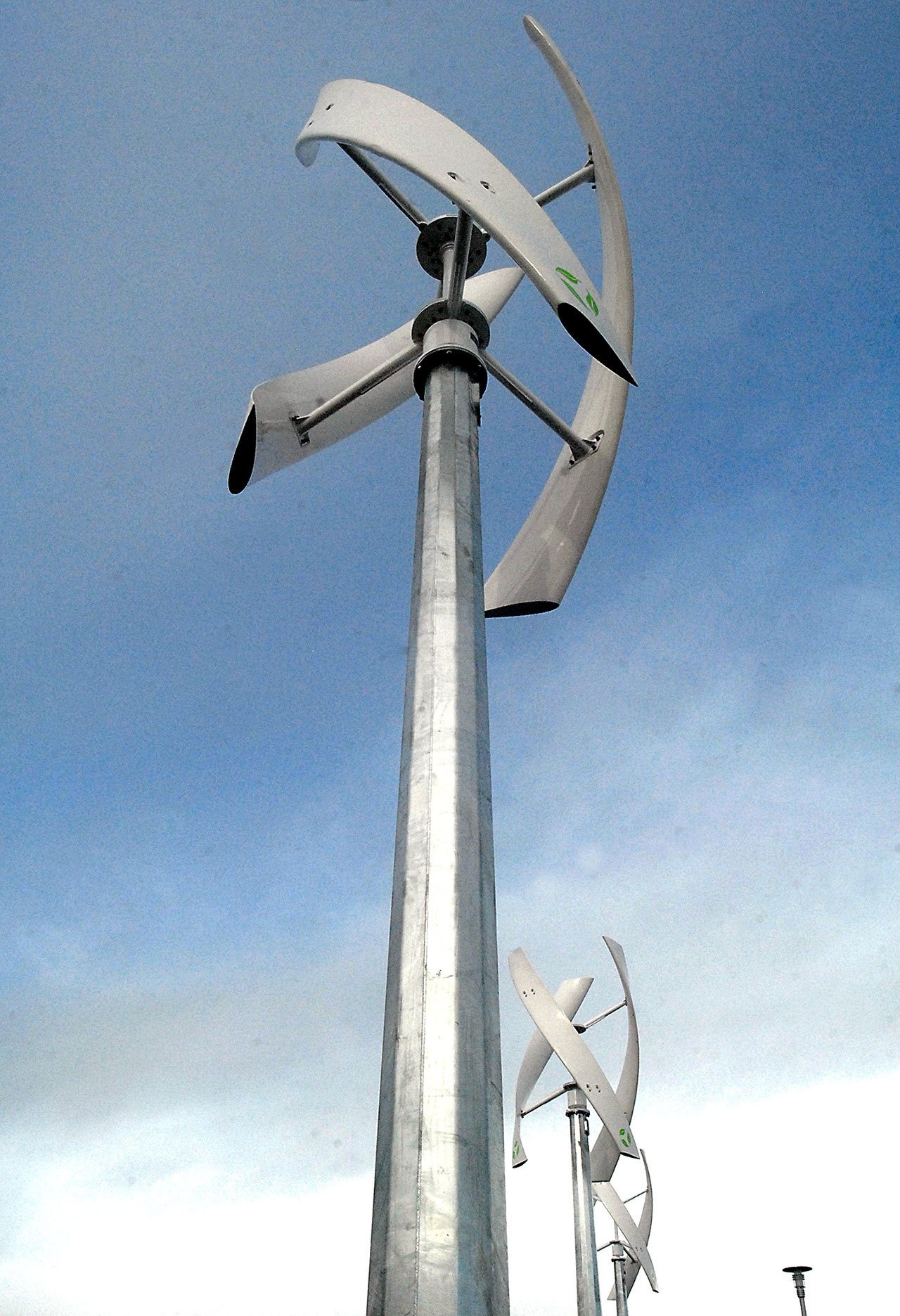PORT ANGELES — Three wind turbines erected at the city’s Waterfront Park in mid-September that cost $107,516 will generate $1.39 worth of electricity a day and about $42 a month — when they are eventually turned on.
Or they will generate an average of $1.85 a day and $55.59 a month, Nathan West, city community economic and development director, said Tuesday. He said Friday that at peak generation, they would provide $168.63 monthly.
The truth is, city officials don’t really know because they can’t predict wind speeds, West said.
An article last Sunday in the Peninsula Daily News erroneously said the windmill-like turbines, put up in September but not yet in operation, would generate about $1.50 a month.
One reason to build the turbines was that they would illuminate the Waterfront Park lights and feed the remaining electricity back into the Bonneville Power Administration grid, city officials said when they approved the project last year.
But the turbines were not built to only generate electricity, West said Tuesday.
They were built “to ensure we have a vertical element to draw visitors to the park,” he said.
“A great deal went into the design of the park. The design was the predominant focus.
“The purpose was not the generation of electricity.”
Shailesh Shere, city assistant director of power systems, said Friday that the turbines’ output of $1.39 a day and $41.70 a month — an estimated $500 a year — was based on operating at 25 percent of peak usage, generating 18 kilowatt hours a day, with an estimate of prevailing wind speeds of 12 to 14 mph for 24 hours.
But West said a more accurate estimate based on historical wind speeds at William R. Fairchild International Airport would be that the turbines will work at an average of 33 percent of peak usage.
The city pays the Bonneville Power Administration 7.7 cents per kilowatt hour for electricity.
That means they would generate $55.44 monthly and $667.28 a year.
“Approximately 25 percent of the year we historically have enough wind to produce peak generation. The other 75 percent, the spires would produce energy at a reduced rate. For that reason, I am assuming average generation at 33 percent of peak,” West said in an email last week.
The wind spires were to “create a vibrant park that had vertical elements, that had artwork … and also provide examples of alternative energy,” West said Friday.
“The intent was not to provide energy for the grid.”
Shailesh said the lights would use 5.45 kilowatt hours a day from the 18 kilowatt hours a day that would be generated.
The remaining 12.55 kilowatt hours a day would be fed back into the grid, earning the city 12.55 times the prevailing retail rate, Shere said.
Over 25 years, or the depreciable life of the equipment, the city would generate about $24,145 of electrical energy, assuming the electrical rate increases 5 percent a year, Shere said.
The turbines are not in use while the city is involved in an inspection-related dispute with the manufacturer, UGE International Ltd. of New York City, West said.
City officials hope to resolve the impasse by January, he added.
Councilman Lee Whetham said when the city council approved the project in October 2015, it was presented as a way to generate electricity for park lighting.
Money was made available for the turbines when the city received a $285,952 Clallam County Opportunity Fund grant.
Whetham said Wednesday he is “absolutely” concerned that the electricity generated by the turbines will not cover the cost of the project.
“As stewards of taxpayer dollars, we should have questioned staff more on this,” Whetham said.
But he did not regret his vote, he said.
“We continue to leapfrog from one hot-button issue to another.”
Mayor Patrick Downie said he likes the wind turbines on the waterfront.
“We were told the purpose of them was to provide the lighting and security needed” at the park, he said.
“It’s a design element to be introduced down there, and that’s fine in itself.
“Let’s give it a chance.
“As a community, we need to be willing to step out of the box and get out of our comfort zone and say, ‘Let’s be willing to consider other alternative resources like those down there.’”
Councilwoman Sissi Bruch said Thursday had she known the turbines were so inefficient, she would have asked city staff to do more research to find a more efficient design.
“I regret the specific design, not the overall turbines,” she said.
________
Senior Staff Writer Paul Gottlieb can be reached at 360-452-2345, ext. 55650, or at paul.gottlieb@peninsuladailynews.com.

